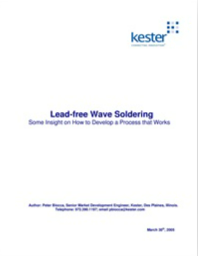Lead-free Wave Soldering
As lead-free gains momentum, many engineers are striving to set-up a wave solder process that maintains production yields but also offer reliable assemblies. Much has been written on these topics in the past 5 years.
Less confusion does exist today about alloy choices available to replace leaded solders, however many are struggling with their successful implementation. Once the lead-free alloy is selected, a solid understanding of its chemical and physical properties is required to enable reliable soldering.
Download this whitepaper to learn more.
Read More
By submitting this form you agree to [publishpress_authors_data field="display_name" post_id="$ID"] contacting you with marketing-related emails or by telephone. You may unsubscribe at any time. [publishpress_authors_data field="display_name" post_id="$ID"] web sites and communications are subject to their Privacy Notice.
By requesting this resource you agree to our terms of use. All data is protected by our Privacy Notice. If you have any further questions please email dataprotection@techpublishhub.com
Related Categories: Components, cooling

